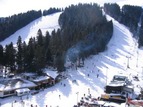Hotels in Kardjali
Shrine of Orpheus
The village of Tatoul, situated about 15 km from Momchilgrad, has recently become extremely popular with the Thracian sanctuary discovered to the south of it.
The village itself is small and quiet. It consists of only a few houses and its population is about 70 people. The people here are Muslims and speak a local dialect, not all of them speak or understand Bulgarian. If you take a walk around the village you will see many domestic animals and birds typical of the Bulgarian villages - turkeys, hens, cows, rabbits etc.
The hill with the sanctuary is situated only about 200-300 m from the village. When observed from a distance it resembles a truncated pyramid. Two piles of stones at its foot suggest that a great deal of work has been done by archaeologists before the imposing ancient construction at the hilltop was uncovered. When you climb up the slope you will find yourself among a multitude of stone platforms and stairs. These are the ruins of and ancient pagan shrine and a medieval castle. When you climb the tpo of the hill you will see two graves carved in the rock.
One of them is in its southern side and is semicircular in shape. The other one is at the top of the rock and is open to the sky. It has the shape of a rectangle with a furrow suggesting that it was covered by a lid. Nickolay Ovcharov, who leads the excavations, proposes the hypothesis that the grave at the top belongs to the Thracian king Orpheus deified after his death. Old legends say that he was such a talented singer that he could enchant wild beasts, rivers and stones with his songs. According to the hypothesis of prof. Venedikov the grave of Orpheus has to be on a high rock so that he can become an intermediary between Gods and humans. There is still no written evidence whether he really existed or was just a mythical figure. However, the recent discovery of a bronze statuette of Orpheus near the hill came as another proof that the sanctuary was dedicated to him.
The Thracians used the sanctuary for sacrifices and for observation of the sunrise and the sunset on the days of the spring and the autumnal equinox.
Archaeologists have found many pieces of ceramic, fragments of stone sculpture and ancient and mediaeval stone epigraphs at the foot of the hill. Rock niches and rock tombs were discovered to the north of the shrine.
Later in the Byzantine Age (4th-7th century AD) a stronghold was built to defend the hill. The remains of a rectangular tower with a water reservoir in its basement can still be seen. The mediaeval village was in the field at the foot of the stronghold, lower than the present-day village and closer to the river. Several mediaeval necropolises, graves lined with stone slabs, have also been discovered.
Although future research is necessary to ascertain whether the grave really belonged to Orpheus, it is known beyond doubt that this place has been considered sacred since ancient times and that it is an element of a much larger complex of sacred structures which is yet to be researched.
Other places of interest in Kardjali
Hotels in Kardjali
Places to go in Kardjali
Deals & discounts in Kardjali
News from Kardjali
- Influx of tourists in Perperikon and Tatul
- Bulgarian and Dutch joint project to develop tourism in Kardzhali
- Bulgaria Thracian City of Perperikon with EUR 2,6 M Tourist Center
- Grandious construction in Kardjali
- Famous Bulgarian Perperikon and Greek Dimotika to become one tourism destination
- The ancient Thracian city of Perperikon
- New Road Leads to Perpericon
- Irishmen and Frenchmen Visit Perperikon
- Ambassadors Become Citizens of Perpericon
- National Geographic Presents Bulgaria
- Walking Paths to be Built in Perpericon
- Church Pulpit Unearthed in Perperikon
 Member of:
Member of:





























 Touroperator
Touroperator
